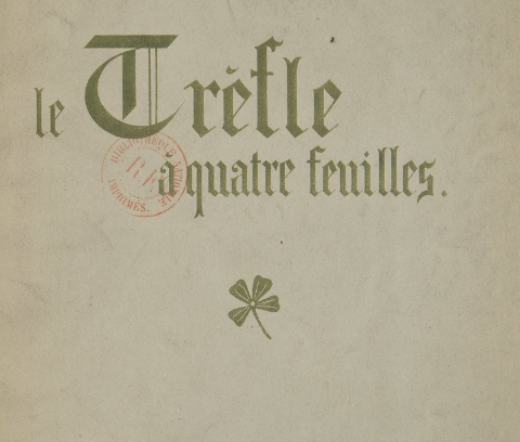
Printed
51 pages
Le Trèfle à quatre feuilles
During the 1890s, the artists of the Théâtre du Chat Noir (Black Cat Theatre) regularly toured in Brussels. When it closed down, imitators reused the name of the theatre to attract an audience. Parisian artists and singers performed in the many cabarets that existed in Brussels at the end of the century. Opened in December 1895, the Cabaret du Diable au corps (literally: cabaret of the devil in the body [avoir le diable au corps is a French idiom meaning “to be a real handful”]) stood out thanks to its review and quality shows. The company’s success took it on tours and required it to move to a bigger room. When it moved to the Rue aux Choux, the cabaret welcomed other companies; from January to March 1898, it was under the direction of Jean Goudezki (who was a regular in the Chat Noir). But the cabaret faced fierce competition: shadow plays were now performed almost every night of the week not only in the Diable au corps, but also in the Théâtre des Phalènes (Theatre of the Moths) and in the Maison de l’Étoile (House of the Star).
Le Trèfle à quatre feuilles (The Four-leaf clover) follows on this trend; it is unique in the works of the composer and organist Valentin Neuville and of his friend Eugène Vial, a poet. Having been trained in the Conservatory of Brussels, Valentin Neuville most likely discovered the cabaret and shadow puppetry during his time. The poetic and musical universal Neuville and Vial created in this play and other collaborative works (such as Prose des mortes [Prose of the Dead Women]) relies on simple language and is imbued with a form of restrained lyricism; the selection of sophisticated images, places and characters are reminiscent of fairy-tales, legends, melancholic poems, and the musings of Symbolist artists.
A young woman sacrifices her freedom for love
As he is hunting with his men, a king meets tumblers travelling from Bohemia in a caravan. He invites them to perform at his palace in the evening. Captivated by the dance of one of the young Bohemian women, the king falls in love. He accommodates the troupe for ten days and asks the woman to meet with him every night. One morning, eager to be free and on the road again, the young woman leaves. Desperate and jealous as lovers consult the oracle of the flowers just under his window, the king feels a surge of anger and officially rules that love is forbidden in the kingdom. Soldiers spy on the lovers, who still meet in secret. Plants wither. Outraged, the people are about to attack the palace; at this moment, however, the young Bohemian comes back: her return and her dance prevent the massacre. Cheered on, she marries the king and gives the lovers the right to love themselves freely again. The four-leaf clovers, which are reminders of unhappy times, are pulled up. The tumblers’ caravan leaves for Bohemia, leaving the young dancer with royal ceremonies that already smother her…
First performance
Théâtre du Diable au corps
Publications and translations
Eugène Vial, Valentin Neuville, Le Trèfle à quatre feuilles, Paris, Alphonse Leduc, 1898.